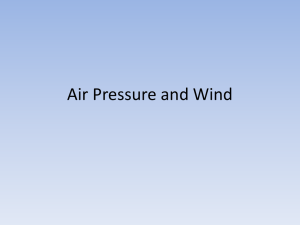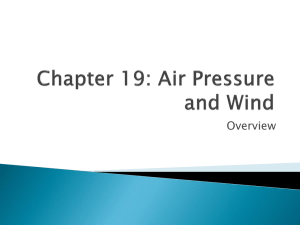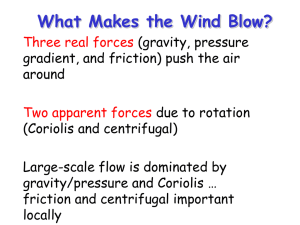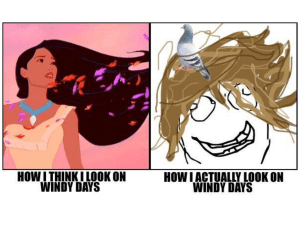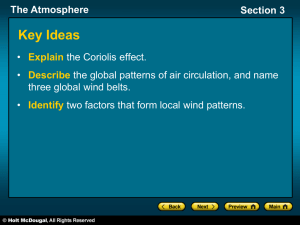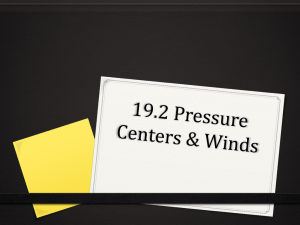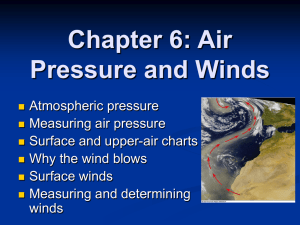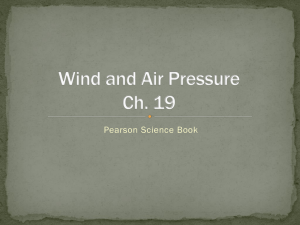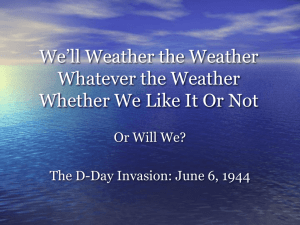8 - Cal State LA - Instructional Web Server
advertisement
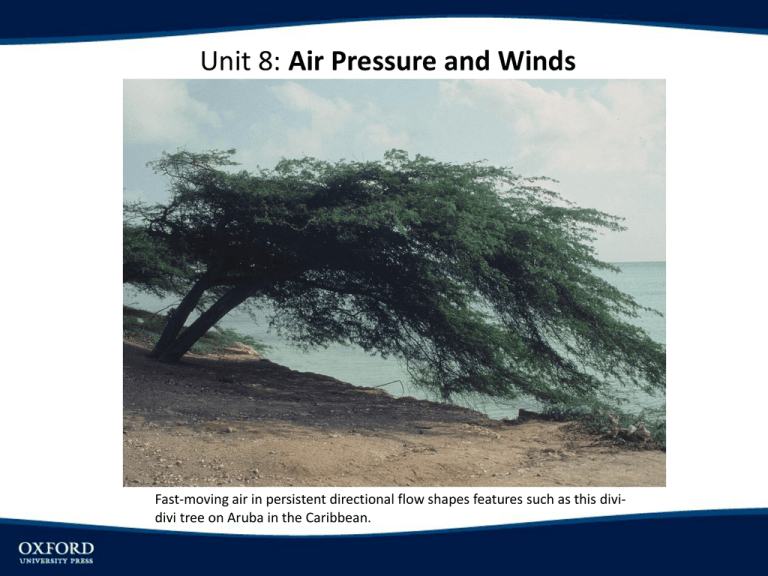
Unit 8: Air Pressure and Winds Author’s photo Fast-moving air in persistent directional flow shapes features such as this dividivi tree on Aruba in the Caribbean. OBJECTIVES • Explain atmospheric pressure and its altitudinal variation • Relate atmospheric pressure to windflow at the surface and aloft • Understand the large scale winds forces affected by pressure systems and air movement. • Apply these relationships to the operation of small-scale local wind systems Atmospheric Pressure • Pressure is a force/unit area vertical pressure is influenced by gravity • Surface pressure, the standard sea-level air pressure is 1013.25 mb (millibars =101.325 hectopascals), about 14.7 lb/in2. • Pressure lines on surface weather chart are called isobars, and are drawn at 4 mb intervals. Source: http://ww2010.atmos.uiuc.edu/(Gl)/guides/maps/sfcobs/cntr/wind.rx ml Measurement of Pressure: The barometer • Invented by Torricelli, a liquid-in-glass barometer. Standard barometer uses mercury. • Standard sea-level pressure is 760 mm (29.92”) • Aneroid barometer, like altimeter in airplanes, uses partial vacuum instrument to measure pressure. The greater the atmospheric pressure, the higher the column of mercury. The values give standard sea-level pressure in several commonly used pressure units. Source: http://apollo.lsc.vsc.edu/classes/met130/notes/ch apter8/p_measure.html Atmospheric Pressure and Altitude Source: http://ww2010.atmos.uiuc.edu/(Gh)/guides/mtr/prs/hght.rxml Mass of the atmosphere as a function of altitude. A greater proportion of the atmospheric mass is concentrated near the Earth’s surface. Atmospheric pressure depends on the overlying mass of air, so it also decreases with altitude. Wind-the Movement of Air in the Atmosphere • Ultimate source of energy for wind is the Sun • Uneven heating by latitudes results in movement of heat towards cooler regions • Air movement is also influenced by the Earth’s rotation-Coriolis force We need to verify we have permission for these two images. Latitudinal radiation balance averaged over the Northern Hemisphere and resulting poleward transfer of heat. Latitudinal profiles of solar radiation absorbed and terrestrial radiation emitted per unit area of Earth’s surface, averaged over all Northern Hemisphere longitudes. The consequent poleward transfer of total heat and the separate atmosphere and ocean transfer components are included. Wind is the movement of air caused by forces: Pressure gradient force • Coriolis force • Friction Surface Winds • Upper Air Winds Source: http://www.lakeeriewx.com/CaseStudies/MesoscaleWin d/ForcesGoverningWind.html Source: http://www.physicalgeography.net/fundamentals/7n.html Pressure gradient force • The pressure gradient force is caused by differences in density (pressure) over distance. The greater this gradient, the stronger is the force. • The direction of the pressure gradient force is always directed from higher to lower pressure. Air movement is always from areas of higher pressure (H) toward areas of lower pressure (L). The larger the pressure difference between H and L, the greater the pressure gradient force and the faster the wind. Source: http://usatoday30.usatoday.com/weather/wpress.htm Coriolis Force • The Coriolis force causes deflection of moving objects, like the wind, to the right of flow in the N. Hemisphere and to the left of flow in the S. Hemisphere. • The magnitude of the Coriolis force increases with velocity and latitude (zero at the equator, maximum at the poles). For the two children on the rotating merry-go-round the ball appears to curve to the right after it is tossed. The child on the adjacent ground observes the ball to move in a straight path. The apparent deflection of an object moving over a rotating surface is created by the different frames of reference, and is accounted for by the Coriolis force. 500-mb Pressure Map Figure 4.10 Frictional Forces • Friction acts opposite the direction of wind, causing slowing. • Its magnitude is determined by the roughness of the Earth’s surface. • Friction decreases with distance away from the Earth’s surface and is insignificant usually above 1 km • Since friction slows winds, it also decreases the Coriolis force that depends on velocity Surface and Upper Air Geostrophic Winds • Above the friction layer, only pressure gradient and Coriolis forces act on winds. • These two forces act in opposite directions, causing a balance called a geostrophic wind. • This wind flows parallel to isobars in the upper air. • Surface winds, with friction, deflect towards lower pressure across isobars. Surface Pressure Systems • Cyclones, or low pressure systems, have counterclockwise (in the N. Hemisphere, opposite in the S. Hemisphere) flow towards the low center, converging. • Anticyclones, or high pressure systems, have clockwise (in the N. Hemisphere) flow outwards towards lower pressures, diverging. Air circulation patterns associated with a cyclonic low-pressure cell (A) and an anticyclonic high-pressure cell (B) in the Northern Hemisphere. In the Southern Hemisphere air circulation around low- and high-pressure cells is in the opposite direction (clockwise toward cyclones and counterclockwise away from anticyclones). Local Wind Systems • • • • Sea breeze/land breeze Mountain/valley breeze Katabatic winds-cold drainage winds Chinook winds, includes Santa Anas, Foehn winds Sea breeze/land breeze air circulation systems. These reversing, cell-like airflows develop in response to minor pressure differentials associated with day/night temperature variations along the land/sea coastal zone. Mountain/Valley Breeze Formation of valley (daytime) and mountain (nighttime) breezes. Red arrows represent upslope and upvalley winds (warmer); blue arrows indicate downslope and downvalley winds (cooler). Source: https://www.meted.ucar.edu/sign_in.php?go_back_to=http%253A%252F%252Fww w.meted.ucar.edu%252Fmesoprim%252Fmtnval%252Fprint.htm Local Winds • Katabatic wind-cold drainage winds, such as off the Antarctic plateau down to the coastal plain. • Chinook (“snow biter”) wind is a warm, dry wind caused by compression as air flow off mountains to lower elevation and higher pressures. Called Foehn wind in the European Alps. Called Santa Ana wind in southern California. • Other local winds have names given due to unusually warm or cold nature. • Warm: sirocco (N. Africa), khamsin (N. Africa), harmatten (W. Africa), sharav (Israel) • Cold: mistral (S. France), bora (Balkans), taku (Alaska) • For other local wind names see: http://windlegends.org/windnames.htm
